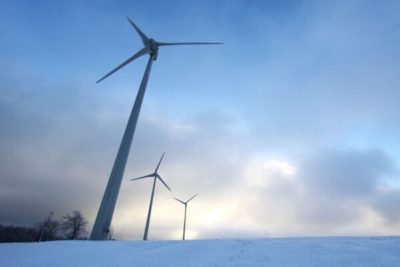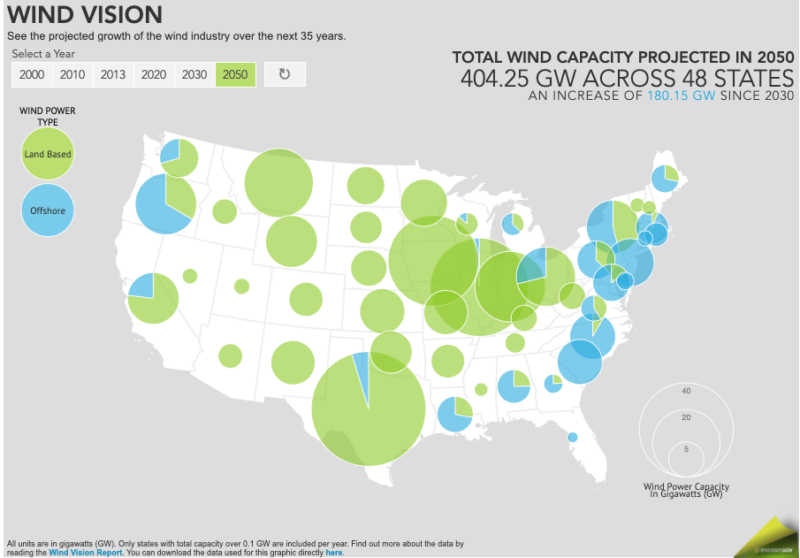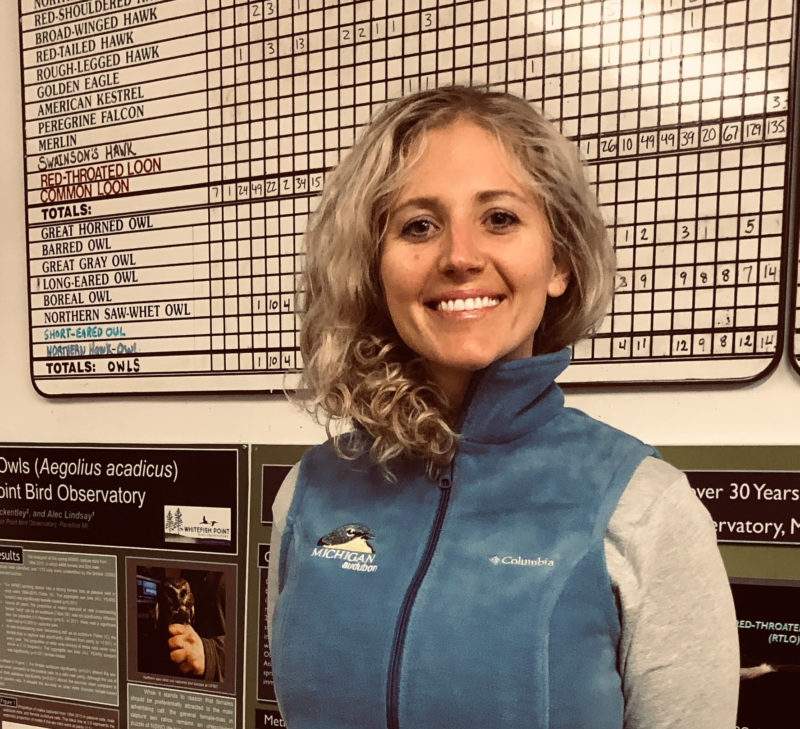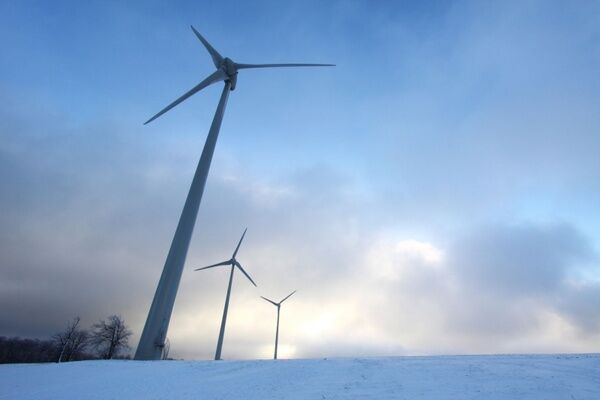From the late 1800s until today, fossil fuels — coal, petroleum, and natural gas — have been our main sources of energy. However, in 2019, the annual energy consumption in the United States from renewable sources exceeded coal consumption for the first time since before 1885, according to the U.S. Energy Information Administration’s (EIA) Monthly Energy Review. “This outcome mainly reflects the continued decline in the amount of coal used for electricity generation over the past decade as well as growth in renewable energy, mostly from wind and solar,” according to the Review.

A wind farm is a development of multiple wind turbines (windmills) in one geographic area where the wind blows at least 14 mph. Depending on the geography of the location, wind farms can contain as few as five wind turbines or as many as 5,000 turbines (as is the case in California, at one of the largest industrial wind farms in the United States).
Shortly after his election last November, President-elect Joe Biden laid out an ambitious plan for decarbonizing the U.S. economy, including a carbon-free power sector by 2035 and net-zero carbon emissions by 2050. These efforts will undoubtedly entail additional, unprecedented investments in a range of “green energy” technologies and industries.
With Governor Gretchen Whitmer’s Executive Directive 2019-12, Michigan joined the United States Climate Alliance, a bipartisan coalition of governors from 25 states devoted to pursuing the goals of the internationally accepted Paris Agreement. These governors banded together to sign this agreement despite the Trump Administration’s withdrawal from that agreement at the time. By signing on, Michigan has committed to pursuing at least a 26–28% reduction below 2005 levels in greenhouse gas emissions by 2025 to accelerate new and existing policies to reduce carbon pollution and promote clean energy deployment at the state and federal level.
This directive is part of a larger, multi-faceted plan, the “MI Healthy Climate Plan,” announced on Sept. 23, 2020. “The science is clear — climate change is directly impacting our public health, environment, our economy, and our families,” said Governor Whitmer. “Through comprehensive and aggressive steps, we will combat the climate crisis by formally setting and relentlessly pursuing a goal of statewide decarbonization by 2050.”
Big Energy = Big Solutions…or Mainly Big Profits?
2019 was the biggest year on record for corporate procurement of wind-generated electricity in the United States. “The economics are driving this,” boasted John Hensley, vice president of research and analytics for the American Wind Energy Association (AWEA). For the critical thinking individual, this claim pretty quickly begs the question — a lot of questions. Essentially, we are left to wonder, with reasonable scrutiny and suspicion, how much we can trust the big business of alternative energy. We wonder, are we really proceeding in a balanced way, one that takes into consideration the environment? Are these technologies the right fit, and is this growth happening all too quickly, and for the right reasons?
In June 2020, Goldman Sachs shared their expectation that “spending for renewable power projects will become the largest area of energy spending in 2021, surpassing upstream oil and gas for the first time in history.” The multinational investment bank and financial services company also expects the clean energy sector to reach a $16 trillion investment volume through 2030, eclipsing fossil fuels.
Wind Energy Industry Growth in Michigan

The Wind Energy Resource Zone board designated Michigan’s Lower Peninsula’s eastern counties near Lake Huron and Saginaw Bay as “areas of strong sustained wind in the state,” which gave way to massive developments of industrial wind farms in the Thumb over the past 10 years. Huron County itself has the largest installed wind energy base in the Great Lakes region.
The upper Thumb region hosts a high-capacity, 140-mile electric transmission line. This project is called the Thumb Loop, capable of carrying electricity from up to 2,800 wind turbines.
Fitting the big picture pattern, the wind energy industry in Michigan has grown tremendously in the last 10–15 years, elevating the state of Michigan to number 12 in the nation for the total number of installed wind turbines. According to the Public Service Commission, as of the end of 2020, Michigan has a total of 1,284 operational wind turbines, producing 3,102 MW of energy.
Add to that, Michigan’s renewable energy mandate requires energy providers to supply 15% of electricity from renewable sources by 2022. Given that energy providers are on track to meet that goal, the rapid development of wind farms doesn’t appear to be slowing down anytime soon.
There are far fewer emissions involved in wind farming as compared to burning fossil fuels. “Wind beats coal by any environmental measure, but that doesn’t mean that its impacts are negligible,” according to David Keith, the Gordon McKay Professor of Applied Physics at the Harvard John A. Paulson School of Engineering and Applied Sciences. “We must quickly transition away from fossil fuels to stop carbon emissions. In doing so, we must make choices between various low-carbon technologies, all of which have some social and environmental impacts.
Conservation Concerns
- Wind power facilities negatively affect birds and other wildlife, especially birds of prey and bats, through direct mortality from collisions with the turbines.
- Wind power facilities can degrade or destroy habitat, cause disturbance and displacement, and disrupt important ecological links.
- The integrity of the land is dramatically altered due to the environmental impacts of turbine construction and maintenance.
Wind energy comes with significant consequences and concerns for people and the environment. “I think it’s always valuable to talk about the balance of impacts versus the benefit of clean energy,” said Joel Merriman, director of the Bird-Smart Wind Energy Campaign for the American Bird Conservancy. “We need renewable energy to combat climate change, but we have to do it in a way that minimizes impacts to birds. That means avoiding development in high-risk locations, incorporating appropriate minimization measures, and mitigating for any impacts.”
Wind Energy Advocacy: What We’d Like to See and What We’re Advocating For
- Mandatory adoption of bird-smart principles for developers that are incorporated in the permitting process.
- Movement by the wind industry toward bird- and bat-friendly bladeless or enclosed-blade technologies to replace the current bladed turbines.
- Regional studies conducted that identify areas where wind energy should not be developed in Michigan due to its potential impacts on protected birds, wildlife, and habitats.
- Pre-construction risk assessments and post-construction monitoring of bird and bat fatalities conducted by independent, third-party experts using standardized methods, followed by the sharing of these results in a manner that is transparent, open to the public, and transmitted directly to regulatory agencies.
- Testing the efficacy of various mitigation techniques and collaborative work with Governor Whitmer’s task force to develop best practices and exemplary state mandates.
- Greater efforts for collaborative, on-the-ground conservation efforts for areas of particular interest (high winds) to developers (i.e., the Upper Peninsula, central-northern Lower Peninsula, and the Thumb of Michigan).
Michigan Audubon’s focus on wind energy is about being a part of informed, science-based planning and advocating for better standards and mandates at the state level. We also want to keep you — people who are invested in the well-being of birds and our greenspaces throughout the lower and upper peninsulas — updated and informed on how they can help.
In each issue of the Jack Pine Warbler this year, we will feature a piece connected to alternative energy in Michigan, community science and advocacy, and outreach that can help us protect our peninsulas for birds and people alike.
Stay tuned for more featured stories on this topic, including the spring 2021 feature story, Wind Energy and Birds in Michigan: The Montcalm Wind Project.
~by Heather Good, Michigan Audubon executive director
This article appeared in the 2021 Winter Jack Pine Warbler.

Heather was a member of Michigan Audubon’s Board of Directors, studied at the University of Michigan’s School of Natural Resources and Environment, and volunteered with birds of prey at the Leslie Science and Nature Center as an independent rehabilitator of raptors before beginning her tenure as executive director in 2016.
Wind Energy References & Resources
- USGCRP 2017, Fourth Climate Assessment.
- IPCC, 2013: Summary for Policymakers. In: Climate Change 2013: The Physical Science Basis. Contribution of Working Group I to the Fifth Assessment Report of the Intergovernmental Panel on Climate Change [Stocker, T.F., D. Qin, G.-K. Plattner, M. Tignor, S.K. Allen, J. Boschung, A. Nauels, Y. Xia, V. Bex and P.M. Midgley (eds.)]. Cambridge University Press, Cambridge, United Kingdom and New York, NY, USA.
- https://nawindpower.com/move-over-hydro-wind-takes-top-spot-for-u-s-renewables-capacity
- https://www.bbc.com/future/article/20200302-how-do-wind-farms-affect-bats-birds-and-other-wildlife
- https://www.energy.gov/eere/articles/why-corporations-are-buying-us-wind-power
- https://news.harvard.edu/gazette/story/2018/10/large-scale-wind-power-has-its-down-side/
- https://www.eia.gov/
- https://www.forbes.com/sites/arielcohen/2020/11/17/goldman-sachs-renewable-power-will-become-the-largest-area-of-spending-in-the-energy-industry-in-2021/?sh=571f468763eb
- https://www.michigan.gov/whitmer/0,9309,7-387-90499_90704-540278–,00.html
- https://abcbirds.org/program/wind-energy-and-birds
- http://css.umich.edu/factsheets/wind-energy-factsheet

